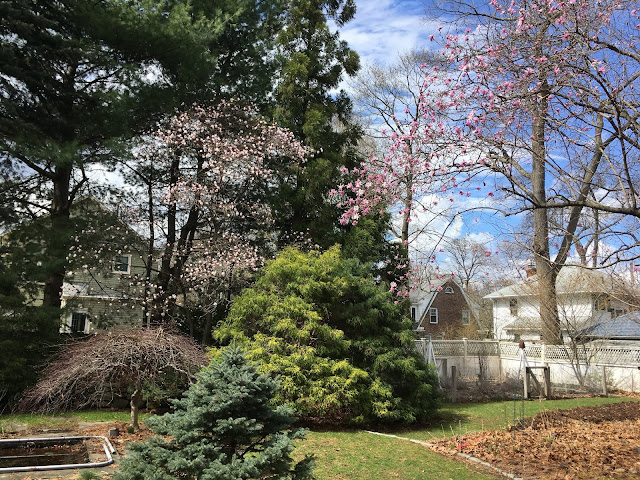 |
| Star magnolia and Magnolia 'Leonard Messel' popped into bloom overnight |
Also burgeoning: invasive plants. These super-survivors start early and finish late, sprinting out of the starting blocks while competitors are still dormant.
 |
| My arch-nemesis, Norway maple, gets a jump on the season |
Before everything else leafs out, providing camouflage, it’s relatively easy to spot the nonnative problem plants. Now is also I time when I’m not dizzily spinning from task to task, as I will be in May.
First on the list, I need to check on Japanese knotweed (Fallopia japonica) that’s surfaced along the south fence line. This could be the year I stick to my plan to foil this potentially powerful land grab. I’m sure you’ve seen Japanese knotweed, because it lines highway shoulders and any other areas where soil is disturbed and then left uncovered.
 |
| Japanese knotweed seizes any open ground |
Once it starts growing, it’s almost immortal. Like many invasives, it makes lots of seeds. The underground part of the plant is the real menace, though. To eradicate stands of Japanese knotweed, the Massachusetts Department of Transportation has to remove all soil down to 3 feet and burn it. That’s because if even a nubbin of root is left, the plant will grow back. My strategy for Japanese knotweed is to cut it to the ground every two weeks. Eventually if it can’t make energy through photosynthesis, it should dwindle and die. At least that’s the theory.
 |
| Last fall I tagged this sprig of Japanese knotweed so I won't miss it |
Garlic mustard (Alliaria petiolata) is another rapid spreader in our area. It’s easy to uproot. I need to catch it all before it flowers and sets seed in its second year, though, or it’ll take over. Garlic mustard emits allelopathic chemicals that suppress other species’ growth. This is one of the few invasive plants in North America that thrives in a shady forest habitat, such as what prevails in much of my yard.
 |
| Garlic mustard impersonating an early perennial |
When I pull or cut down these plants, I can’t throw them on the compost pile. If I did, I’d be spreading the unwanted plants whenever I distribute compost. It goes against the grain to bag invasives and throw them in the regular trash, but adding them to the yard waste would pass them on to someone else’s garden.
 |
| Volunteer pulling garlic mustard at Cuyahoga Valley National Park-photo NPS/Arrye Rosser |
Of course, officially recognized invasives aren’t the only plants growing aggressively in my garden. Lots of plants I chose myself, including native smooth Solomon’s seal (Polygonatum biflorum), have turned out to be thugs that I have to beat back every year.
 |
| Smooth Solomon's seal shooting up from the leaf litter this week |
I don’t like to get too hysterical about invasive plants. They’re mostly responding to human alterations of plant habitat, diving in to pioneer newly disturbed soil. The nonnative invasives in my yard didn’t parachute in from abroad, they just made it under the fence from adjoining properties where people are less interested in policing the landscape. Spending some gardening time keeping them at bay does seem worthwhile, though. The more garden space they claim, the less there’ll be for a diverse landscape that includes native plants.
 |
| With help, I hope native inkberry will grow instead of Japanese knotweed |
No comments:
Post a Comment